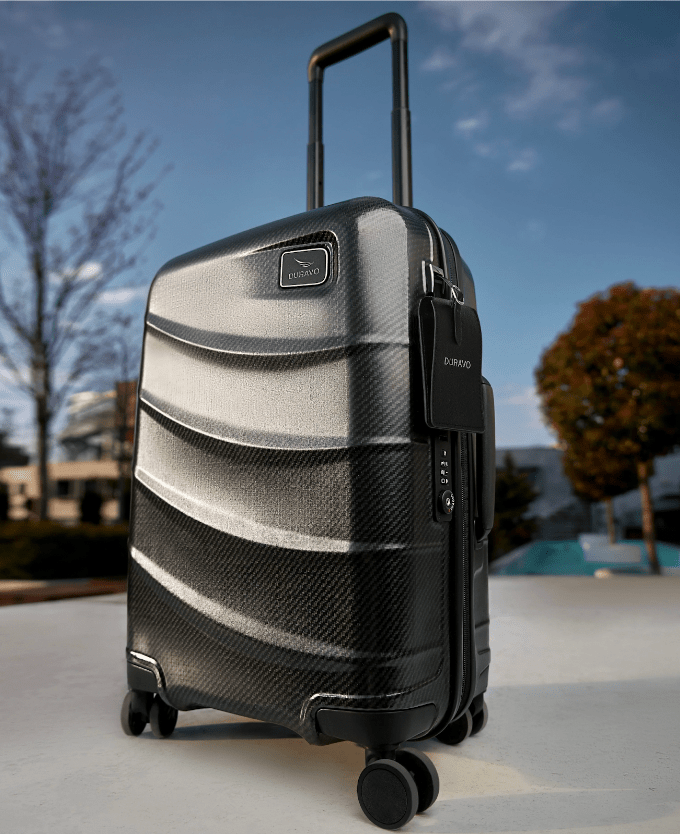Lifestyle
Duravo’s Success Story: Engineering the Perfect Suitcase

By: Mae Cornes
When Matt Muhr and Dan Cooper founded Duravo, they started with something other than luggage design. Instead, their journey began unexpectedly: the world of tactical and anti-ballistic gear. This unconventional background led them to discover a self-reinforced composite material used in professional sports equipment, military gear, and automotive components.
Working closely with a German engineering team, Muhr and Cooper developed Flexshell™, a material that combines strength and lightness. “We saw an opportunity to bring advanced materials science to an industry that hadn’t seen significant innovation in decades,” Muhr explained.
A Lightweight Contender in a Heavy-Duty Market
Duravo’s entry into the luggage market came at a time when established brands dominated the landscape. However, the company’s focus on material innovation sets it apart from competitors.
The Duravo International, an expandable carry-on, weighs just 5 pounds, making it significantly lighter than many competitors’ offerings. This weight reduction doesn’t come at the cost of durability or capacity. The suitcase expands from 37 liters to 46 liters, providing travelers with flexibility without exceeding airline size restrictions.
Cooper noted, “Our goal wasn’t just to make another suitcase. We wanted to change how people think about luggage durability and weight fundamentally.”
Rigorous Testing: Proving Durability in the Lab and on the Road
To validate its claims about Flexshell’s durability, Duravo invested heavily in product testing. The company reports subjecting its luggage to weighted tumble tests, extreme drop tests, and thousands of handle yanks.
The company does not publicly share specific test results, but it states that Flexshell provides five times the strength of traditional plastics used in luggage. This claim would represent a significant advancement in luggage materials if independently verified.
Technology Integration: Beyond Basic Storage
Duravo’s products incorporate several tech-friendly features, reflecting the changing needs of modern travelers. The luggage includes built-in USB access for charging devices, a hidden sleeve for tracking devices like AirTags, and compartments designed to protect electronics during travel.
These additions address common pain points for travelers, such as keeping devices charged and preventing lost luggage. However, it’s worth noting that some of these features, such as USB charging ports, are becoming increasingly common in premium luggage offerings.
Market Performance and Customer Reception
Since its launch a year ago, Duravo reports generating over 1,500 customers. While this number suggests steady growth, it’s modest compared to established brands in the luggage industry. The company currently limits its market to the U.S. and Canada, indicating potential for expansion.
The company reports positive customer reviews, a critical factor in the luggage industry, with an online star rating of 5 out of 5. However, independent verification of these ratings and a larger sample size would provide a more comprehensive picture of customer satisfaction.
Challenges and Competition in a Crowded Market
Despite its inventive method, Duravo faces significant challenges. Established brands like Away, Monos, and Tumi command substantial market share and brand recognition in a highly competitive luggage market.
Duravo’s focus on high-end materials and manufacturing in Germany will likely result in higher production costs. This could make it difficult for the company to compete on price with brands that manufacture in regions with lower production costs.
Environmental Considerations and Future Directions
Duravo emphasizes the eco-friendly nature of its products, stating that Flexshell is recyclable. However, specific data on the material’s environmental impact throughout its lifecycle is not readily available. As sustainability becomes increasingly important for consumers, more transparent and detailed environmental information could benefit the company’s market position.
Duravo’s success may hinge on its ability to scale production while maintaining quality, expand its product line, and effectively communicate its value proposition to a broader audience. The luggage industry’s recovery and growth following the COVID-19 pandemic will also play a crucial role in shaping the company’s trajectory.
As Duravo continues developing its brand and product line, its story is an interesting case study in bringing materials innovation to a well-established consumer goods category. The company’s future success will depend on its ability to balance innovation with market demands and effectively compete with more prominent, established brands.
Lifestyle
How Magic Moment Resort Became the Pioneer of a New Era: The First-Ever Dazzler Select by Wyndham

In Central Florida’s packed landscape of family hotels and theme park lodgings, a unique kind of property has emerged. Magic Moment Resort & Kids Club in Orlando is earning attention from traveling families for a simple reason. It delivers joy, warmth, and convenience at a smart value that keeps Disney dreams accessible rather than overwhelming.
By joining Wyndham, Magic Moment Resort unlocks the strength of a global powerhouse, gaining worldwide visibility, advanced technology, and access to Wyndham Rewards, the largest hotel loyalty program on the planet. This strategic move expands its reach, builds guest trust, and amplifies its impact, all while preserving the unique identity that sets it apart.
Just a short drive from the gates of Walt Disney World, the resort sits along the palm-framed stretch of West Irlo Bronson Memorial Highway. The location has long been known for its tourism bustle, yet Magic Moment has carved out a softer identity. It feels playful and colorful, but also intentional. It is designed by a family for other families, and that perspective shapes every experience on the property.
A Philosophy Rooted in Family Connection
Magic Moment Resort was built with a belief often forgotten in today’s tourism industry. Family vacations should feel uplifting instead of stressful, and affordability should not come at the expense of comfort or creativity.
Check-in feels more personal than transactional. Parents arrive with strollers, snacks, and tired children. The staff seems to understand this rhythm instinctively. The energy is warm, the pace is easy, and the tone is set long before anyone even enters the room.
Unlike competing hotels that charge a steep premium for proximity to the parks, Magic Moment focuses on smart value without compromise. Its pricing strategy is refreshingly straightforward. Families can stay five minutes from Disney without draining their travel budgets. For many guests, that difference helps shift resources from hotel costs to experiences. It means more character breakfasts, more souvenirs, and more freedom to enjoy the parks without financial tension following every decision.
Spaces Designed for Children and Considerate of Parents
Magic Moment is filled with color, but nothing feels overstimulating. Instead, the resort offers a sense of wonder scaled to a child’s imagination.
The themed family rooms are a highlight. Children step into rooms that feel lighthearted and whimsical, yet parents appreciate that they are also functional and comfortable. It is the atmosphere of a themed suite without the theme park price.
Its Kids Club and Teens Club reflect that same thoughtful balance. These spaces invite exploration and creativity for children and provide a nurturing level of supervision. Parents can enjoy an hour by the heated pool, relax in a shaded cabana, or simply take a quiet moment while knowing their children are safe and engaged.
The resort’s grounds encourage slow mornings and gentle afternoons.There’s a 30,000 sqf outdoor playground as well as peaceful corners for parents. Importantly, families are not asked to pay additional fees to enjoy them. Magic Moment’s amenities feel generous rather than transactional.
Unforgettable Days at the Parks
For families navigating a Disney vacation, convenience is often the true luxury. Magic Moment delivers this with a complimentary delicious hot breakfast that encourages everyone to sit and enjoy the start of the day rather than rush through it.
Transportation to the parks is included, which removes one of the most common stress points for visiting families. There is no parking lot maze and no long lines at the toll booths. Guests simply board the shuttle and begin their day with ease.
When the sun sets and everyone returns from a day of rides and parades, the resort becomes a place to unwind. Children head straight for the pool. Parents sip Starbucks coffee. The atmosphere is relaxed and bright, and the resort feels like an extension of the Disney experience rather than a pause from it.
A Value That Resonates with Families
What truly elevates Magic Moment is the balance it achieves between smart value and experience. The resort has cultivated a loyal following because guests feel they receive more than they pay for. More thoughtful design. More space for connection. More comfort without excess.
Affordability here does not signal minimalism. Instead, it allows families to breathe. It creates space for shared moments that are often overlooked in the rush of theme-park vacations. Children play freely. Parents unwind without guilt. Families spend more time together and less time navigating logistics.
A Resort Built with Heart
Magic Moment Resort & Kids Club stands out in a region overflowing with hospitality options. Its charm is not rooted in extravagance. It is grounded in sincerity. It reflects the belief that family travel should feel joyful, accessible, and full of color.
For families planning a Disney visit, it represents more than a place to sleep. It is a retreat where memories can form in the quiet moments as much as in the thrilling ones.
At Magic Moment, the greatest luxury is not an amenity. It is the feeling of being exactly where you are meant to be, together.
-

 Tech5 years ago
Tech5 years agoEffuel Reviews (2021) – Effuel ECO OBD2 Saves Fuel, and Reduce Gas Cost? Effuel Customer Reviews
-

 Tech6 years ago
Tech6 years agoBosch Power Tools India Launches ‘Cordless Matlab Bosch’ Campaign to Demonstrate the Power of Cordless
-

 Lifestyle6 years ago
Lifestyle6 years agoCatholic Cases App brings Church’s Moral Teachings to Androids and iPhones
-

 Lifestyle5 years ago
Lifestyle5 years agoEast Side Hype x Billionaire Boys Club. Hottest New Streetwear Releases in Utah.
-

 Tech7 years ago
Tech7 years agoCloud Buyers & Investors to Profit in the Future
-

 Lifestyle5 years ago
Lifestyle5 years agoThe Midas of Cosmetic Dermatology: Dr. Simon Ourian
-

 Health7 years ago
Health7 years agoCBDistillery Review: Is it a scam?
-

 Entertainment6 years ago
Entertainment6 years agoAvengers Endgame now Available on 123Movies for Download & Streaming for Free
